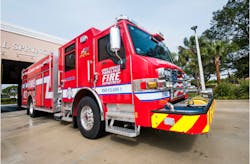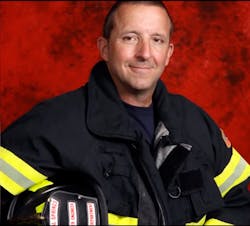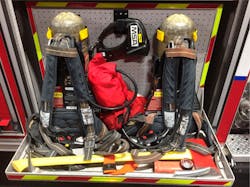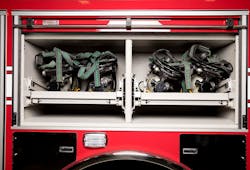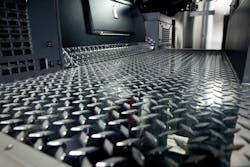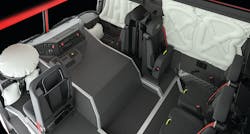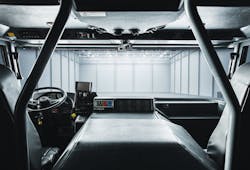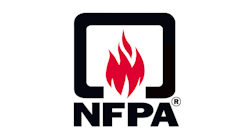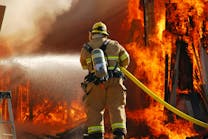Apparatus Makers, Fire Chief Share Practical Tips for Keeping Cabs Clean
A department taking charge
Coral Springs-Parkland Fire Chief Frank Babinec says his department was experiencing an “uptick” in firefighters diagnosed with cancer and he and the department decided to do something about it. He says when the clean cab concept was brought to him, he was receptive. “We decided to ... try to design [a truck] for the safety, health and welfare of our firefighters, rather than build something just around what a traditional fire apparatus would look like, and that’s what we did,” he says.
After the platform aerial was delivered, Babinec says his department decided to look at the entire fleet and see what could be done to have every apparatus feature the clean cab concept. He brought in the University of Miami, which is doing fire cancer research at the Sylvester Cancer Research Center.
With representatives from the Center, Babinec says his firefighters went through an extensive educational program to explain why the department was embarking on this clean cab kick. “I believe that once you explain the why to first responders, they tend to be more accepting of change,” he says. The department was on board with the idea of reducing carcinogens in the cab and Babinec set to change the fire suppression fleet. “As of today, every suppression apparatus I have on the road is designed to clean cab standards,” Babinec says.
Ironically, there really are no formal standards for clean cab designs. Fire departments and manufacturers are pioneering the subject matter and are creating some generic standards, all aimed at keeping firefighters safe and reducing the exposure to contaminants in apparatus cabs. For Babinec, the standard is simple. Anything that has been contaminated at a fire scene should not go into the cab.
“The technical definition of a clean cab is anything that goes into an IDLH (immediately dangerous to life or health) environment doesn’t go back into the cab of the apparatus until it has been properly decon’ed,” Babinec says. “We could have a long discussion about what properly decon’ed means, because I don’t think we know what it means yet. There’re a lot of studies out there looking at that.”
Babinec says his department has created a 64-page document to share with departments interested in the clean cab concept, spelling out exactly what they’ve done to their apparatus.
One of the biggest changes is that airpacks are stored in the officer’s side front compartment. “Once our firefighters step off the apparatus, they make a U-turn right into the compartment with all the gear right in it,” Babinec explains. “Within 10 seconds, they’re stepping away from that compartment with everything they need to go to fight a fire. If they look back and if anything is left in that compartment, they’ve forgot something.”
Babinec says the practice prevents loss of time with firefighters having to go back into their cabs to retrieve equipment. In addition to the airpacks, the rally compartment contains flashlights just for use in contaminated environments, forcible entry tools, all within easy reach of the fire hoses. Flashlights are color-coded with yellow being allowed in the cab, as they are not used in IDLH environments, and orange remaining outside the cab.Firefighters are allowed to have clean bunker gear in the cab, which means they are dressed for the occasion, but the airpacks are stored outside the cabs, which is not a new concept, says Babinec, harking back to the days when it was standard to have the SCBAs in compartments outside the cabs because there was no technology to have them stored inside.
Since removing fire equipment from the cabs, Babinec says Coral Springs-Parkland Fire Department has seen a significant reduction in ankle, knee, back and shoulder injuries. Another benefit is that firefighters are forced to take a couple of moments to do some size-up and situational awareness while gearing up.
Partnership with manufacturers
More passive precautions the department has taken include specifying vinyl seats for all firefighters, due to the fact that they are easy to decontaminate by wiping and cleaning. Babinec says he would like to see apparatus manufacturers work on creating comfortable seats with fewer seams. Babinec asked that the apparatus maker, in this casePierce Manufacturing, to create floor surfaces with as few seams as possible and all electronic and electric hardware elevated off the floor so the apparatus can be washed out with a hose and cleaned more easily.Smoothed surfaces are also used throughout so they can be wiped down and decontaminated easily, Babinec says, and special HEPA filters help eliminate microscopic particles that might contaminate the cab environment.
His apparatus also features vertical exhaust stacks to keep diesel emissions out of the cab, the main initiative of the clean cab concept. He is also working with the apparatus manufacturer to have an interlock mechanism to have all the power windows close when the truck is in pumping mode. That would be a feature for future apparatus, he says.
Babinecnotes that his department is happy with the concept they’ve developed and says he plans to have 100 percent of his fleet be included in the clean cab program by the end of 2020. The department is currently running about 16,000 calls annually in a 40-square-mile area, protecting a population of 160,000 residents. His firefighters are also paramedics and 70 percent of the calls are EMS-related. That means firefighters spend a significant amount of time in the apparatus cabs, which is why it’s important to reduce the exposure to carcinogens, he explains.“The biggest thing is training and decontamination,” he says, noting that a significant portion of the 64-page document his department created is dedicated to when and how to do thorough decontamination. In fact, Babinec’s request, Pierce added an automatic feature to the apparatus command instrumentation that reminds firefighters that a comprehensive decontamination must be done every 30 days. “You can spend a lot of time and effort on the clean cab concept, but if you can’t maintain it, what you are doing? You’re spinning your wheels,” Babinec says. “You’ve got to train your people to do proper decon and to maintain the integrity of the environment once you’ve created it.”
Over the past couple of years, apparatus manufacturers have spent a great deal of time and effort to create features designed to help firefighters keep their apparatus cabs clean.
Scott Wieshaar, Spartan Motors’ executive director of product development, says the clean cab concept has been a “hot topic” for months, but there’s no standard, or definition for what it means exactly. “I have yet to find two fire departments that view clean cabs the same way,” Wieshaar explains. “It’s a rather obtuse subject and it means different things for different people.”
That’s why Spartan is spending time listening to customers and giving them what they think they need to complete achieve their goals, Wieshaar says. For Spartan, many of the features customers require for clean cabs are already built into the company’s cabs. For instance, Spartan has been offering a flat floor design - ideal for decontaminating washouts - for years, he says. Spartan has also been working on eliminating “nooks and crannies” where contaminants can hide and be difficult to remove, Wieshaarnotes. The company has also offered a variety of external cab compartments for years, and many of them well-suited for the storage of contaminated fire gear and equipment.“We’ve got a whole variety of external cabinets on our cabs,” Wieshaar says. “They can be used for turnout gear, SCBA storage, etc., so you don’t have to bring that stuff into the cab.”Spartan is also working on a number of different coatings and surfaces for cab interiors, all with the intent of making them easier to wipe down during decontamination. The heating, air conditioning and ventilation system developed by Spartan is exceptionally well designed for the clean cab concept in that it’s oversized and can rapidly cool down or warm up cab interiors, Wieshaar says. “The system is oversized for the cabin, which means air is circulated through a HEPA filter many times in a short period of time, which means we grab a lot more those particles that are inhaled or settle on surfaces,” he notes.
Spartan has also developed a wash down system for gross decontamination of firefighters and their gear, noting the company has a water heater for firefighter comfort and a separate 12-volt pump system for the wash down so the apparatus fire pump doesn’t have to be engaged for decontamination. Spartan has developed a clean cab that will be demonstrated at trade shows late this summer and fall, showcasing all the company has to offer, Wieshaar says.
Listening to customers and spreading awareness
Pierce Manufacturing is in the same stage of clean cab development, listening to customers, including Coral Springs-Parkland, and coming up with sensible solutions to the problem, said Dave Roloff, Pierce’s manager of sales and market development, custom cab and chassis. “What we want to do is provide a complete awareness of what is going on out there,” Roloff says.
Keeping cabs clean doesn’t have to be a complicated or expensive process, Roloff continues. “It can be simple things like making sure the windows are up while at a scene,” he notes. “Just rolling up your windows can reduce a lot of contamination and debris inside the cab.”
Steering customers toward cleanable, smooth surfaces is also another low-cost solution to keeping cabs clean, he says, noting that reducing porous surfaces, like those found on fabric seats will go a long way to reducing carcinogens in cabs. Something else to consider is lighter color interior surfaces so particulates on surfaces will be more easily seen and removed.
Roloff says he’s found that all the major apparatus seat manufacturers are more than willing to work with customers and apparatus manufacturers to come up with the best seat surfaces. It’s Pierce’s job to educate its customers as to what is available to help them achieve their goals. One significant way Pierce has done that is through its Carcinogen Awareness & Reduction to Exposure (CARE) initiative, which is a partnership between Pierce and the Firefighter Cancer Support Network, Roloff says.“We hear more and more that the number one killer of firefighters is cancer,” Roloff says. “There are some things you can’t control on firegrounds, like the man-made materials burning dirtier than the natural materials of yesterday.” That’s why it’s important to take control of things like contamination in the cabs, he explains. “We can’t solve the problem, but we can help reduce the problem,” Roloff says. “Unfortunately, we don’t have the silver magic bullet.”
Mike Schneider, a sales representative for Ten-8 Fire Equipment, a Pierce dealer in southeast Florida, knows all too well the personal cost of firefighter cancer – he worked with Coral Springs-Parkland Firefighter Pietrafesa, the driver engineer who succumbed to pancreatic cancer.
Schneider worked with Pietrafesa on developing the department’s clean cab apparatus.
“It’s a topic that is near and dear to me,” he says, noting that he lost a close friend in the passing of Pietrafesa. “I’ve been trying to have the conversation with all the fire departments I work with. My approach is, have the conversation and then leave it up to the department. …I have seen the videos. I’ve sat with the doctors from Miami. I’ve heard the statistics. It’s a very important subject.”
And if there are firefighters and departments that need convincing, Coral Springs-Parkland Chief Babinec suggests they view a video his crew made documenting Pietrafesa’s story and that of the department:
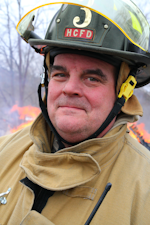
Ed Ballam
Ed Ballam served as associate editor for Firehouse. He is the assistant chief of the Haverhill Corner, N.H. Fire Department, and a National Registered EMT. He is also a Deputy Forest Fire Warden for the New Hampshire Division of Forests and Lands. Professionally, he's been a journalist for over 35 years working for a variety of publications, including employment as managing editor of a national fire service trade journal for more than a decade.
